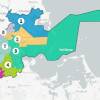Challengers and defenders of Boston’s newest voting district boundaries delivered final arguments before a federal judge Wednesday, wrapping up the public portion of a case that could have implications for the city’s neighborhoods and local elections going forward. Judge Patti B. Saris will now decide whether to block the city’s most recently revised map from defining political districts over the next decade.
Saris said earlier this week that she intends to review about 20 hours of recordings from the city’s redistricting hearings before issuing a ruling. Those familiar with the legal arguments of the case suggested her decision may come down to her interpretation of how heavily councilors weighed race in those proceedings — and specifically whether they used race appropriately in the redistricting process, as defense attorneys argued, or wrongfully prioritized it, as challengers insisted.
Attorneys for those against the new map argued the plan, approved by both the Boston City Council on a 9-4 vote and Mayor Michelle Wu, was the result of racial gerrymandering that placed “racial balancing” above other map-drawing factors in violation of the 14th Amendment.
Wednesday’s closing arguments followed five days of testimony, mostly from white politicians with deep personal ties to South Boston and Dorchester who were not pleased with the new map. The two neighborhoods are where the bulk of boundary shifts occurred in the most recent redistricting cycle due to a population swell in South Boston’s Seaport and a population shortage in one of two districts that cover Dorchester.
Paul Gannon, one of the three attorneys challenging the map, characterized the redistricting process as “a charade” disguising a nefarious plan to gut the “heart and soul” of the city’s Dorchester-based third district in Neponset and Cedar Grove.
The result, he argued, ultimately targeted white super-voters who consistently turn out for elections at higher-than-average proportions. By unnecessarily shifting them from one voting district into a neighboring district, the council diluted voting power in a long-held Black majority district and violated the Voting Rights Act, Gannon and his team argued.
On the other side, attorneys defending the map said the shifted super-voting white precincts prioritized the area’s neighborhood cohesion. They pointed to a City Council committee report, which outlines concerns about community cohesion in Roslindale, Dorchester’s Fields Corner section and South Boston’s Villa Victoria and Cathedral housing projects that informed the ultimately approved map.
That committee report seemed key to Saris’ understanding of the case Wednesday. Before defending attorneys pointed to it, she noted repeatedly that her ability to understand the council’s rationale for the redistricting plan was “impaired.”
“All I have is a series of racial comments,” she said, noting that no councilors testified in defense of the map.
But Saris also spent a portion of closing arguments quizzing attorneys for both sides on what might be an acceptable remedy if she were to find fault with Boston’s map-making process.
Potential alternatives
Gannon said the city should revert back to its old map, an assertion Saris immediately dismissed since the old map contains unconstitutional population imbalances. Gannon then recommended a special master to redraw the city’s voting boundaries, an action taken in New York state last year after the state’s highest court threw out the newly redrawn districts.
The map at issue represents the first such plan that emerged from a Boston City Council dominated by councilors of color, a shift that occurred in 2020 . It’s a fact that Boston City Councilor Ricardo Arroyo, who helped move the ultimately enacted map, said is curious outside the courthouse Wednesday.
“I think it’s always interesting when there’s an allegation that there is some kind of offense being propagated against Black or Latino residents in the City of Boston, but you haven’t seen any Black or Latino elected officials” testifying against the city’s redistricting process, he said Wednesday, calling the suit a “bad faith effort” to overturn the map.
Opponents also argued the City Council pushed to pass the map without giving adequate public notice for all of the gatherings in which the matter was discussed.
U.S. Rep. Stephen Lynch, former Boston City Clerk and Councilor Maureen Feeney and sitting Councilors Michael Flaherty and Erin Murphy all testified over the course of the hearing. Flaherty and Lynch repeatedly alleged that the map diminishes the ability of public housing residents in South Boston to achieve effective political representation.
An expert withness outlines her data
During the days of testimony, attorneys for the city defended the map-making process with a single witness: Moon Duchin, a professor and redistricting lab director at Tufts University. She said her analysis showed the new map amounted to a “status quo” plan that retained a high degree of similarity with the old map and that it allowed voters of color to elect candidates of their choice.
The expert also testified the new map lacked “significant change” to demographics and split precincts, two hallmark indicators of racial gerrymandering.
During cross examination, Duchin avoided answering questions about connections between the ultimately enacted map and the City Council’s intent, but conceded that the city’s voting map could have been redrawn with fewer moves than the council ultimately agreed to.
Judge Saris said repeatedly Wednesday that she needed to review the City Council redistricting recordings before delivering a decision that could interrupt the city’s municipal voting schedule and the slate of candidates seeking to represent the city for the year.
“Don’t expect an opinion right away,” she told the court after arguments concluded.







